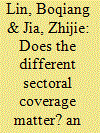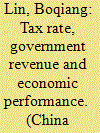| Srl | Item |
| 1 |
ID:
171413


|
|
|
|
|
| Summary/Abstract |
By the end of 2017, China formally established the national carbon trading market, however, only electricity industry was eligible to participate in the emission trading scheme (ETS). This paper aims to answer the question as to what should China do after the first step of establishing China's national ETS market using a dynamic recursive CGE model with six scenarios from different coverage according to relevant documents. The results show that when more industries are covered in ETS market it will lead to a higher GDP performance and less ETS price in general. Since the trading price is related to the marginal emission reduction cost of enterprises, the coverage of enterprises with low emission reduction cost can bring lower prices. However, there is no direct relationship between carbon price and emission reduction, as the coverage is different in different. There is no obvious relationship between the additional burden of enterprises and emission reduction, it is only related to carbon price and the coverage. Finally, we find that after covering the power generation industry, the carbon market should cover other primary energy production enterprises, which will bring much better emission reduction benefits than the original plan of the National Development and Reform Commission in China.
|
|
|
|
|
|
|
|
|
|
|
|
|
|
|
|
| 2 |
ID:
168362


|
|
|
|
|
| Summary/Abstract |
The Laffer curve illustrates a theoretical relationship between rates of taxation and the resulting levels of government revenue. This paper explores the relationship between tax rate (direct tax on labor income), government revenue and economic performance in a perspective of the Laffer curve by applying Computable General Equilibrium (CGE) model. The results show that the top of China's Laffer curve is about 40%. The government should consider changes in the entire taxation system and not just changes in direct taxes while increasing direct tax rate. If China wants to maximize tax revenues, the direct tax rate should be 35%. We conduct a variety of sensitivity analyses and conclude that the government tax peak is always 5–10% earlier than the apex of the Laffer curve. So, if a country has reached the top of the Laffer curve, this paper strongly recommends that tax cuts will have positive implications for the economy and government revenue.
|
|
|
|
|
|
|
|
|
|
|
|
|
|
|
|